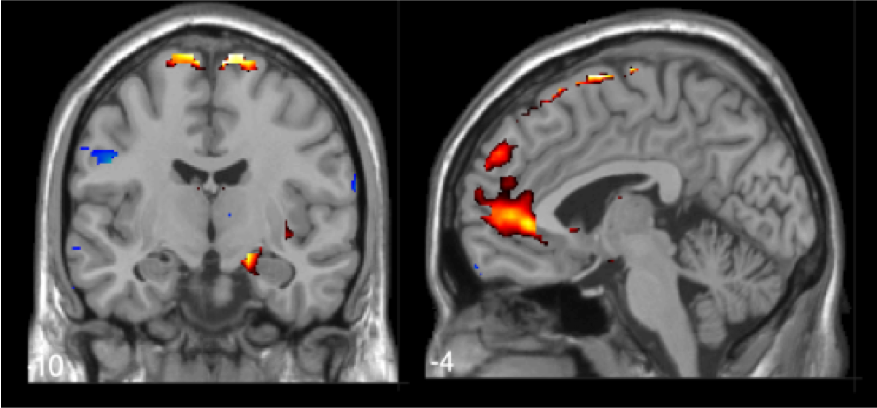Same signature for several mental illnesses
A team from NCCR-Synapsy has identified a common neurobiological signature of dysfunction in the brain circuits involved in regulating emotions in three clinically-distinct psychiatric illnesses.
People suffering from attention-deficit hyperactivity disorder (ADHD), bipolar disorder or borderline personality disorder share a common symptom of emotional lability that consists of intense, changing emotions that are hard to control. A team of neuroscientists from the Synapsy National Centre of Competence (NCCR-Synapsy) based at the University of Geneva (UNIGE) has examined the neurobiological foundations of this emotional lability. The scientists were looking for the biomarkers of these disorders so they could more easily identify and distinguish what they have in common and what is specific to each for diagnosis and treatment. The researchers correlated the emotional lability levels of a cohort of transdiagnostic patients diagnosed with one of the three disorders with the variability of resting brain activity measured using magnetic resonance imaging. The fronto-limbic brain network was shown to be dysfunctional, regardless of the type of clinical diagnosis. This study, published in the journal Translational Psychiatry, shows that the three psychiatric disorders have a common neurobiological basis, marking a step towards early interventions for their prevention.
Disorders affecting emotional regulation are widespread, with epidemiological data indicating a prevalence of between 1% and 2.5% for bipolar disorder; 2.5 to 4% for borderline personality disorder; and between 2.5% and 5% for ADHD. These disorders are probably linked to the development of emotional regulation circuits during adolescence. The team led by Camille Nemitz-Piguet, a researcher at UNIGE’s Department of Psychiatry, carried out a study to determine whether this transdiagnostic clinical trait had a common biological basis.
Transdiagnostic cohort
“The clinical diagnosis for these three disorders is made following a patient-doctor interview”, says Dr Nemitz-Piguet. And it is on this basis that the neuroscientist’s team established a transdiagnostic cohort made up of individuals treated by HUG’s Psychiatric Specialties Division who were suffering from the three mental illnesses, alongside symptom-free subjects as “healthy controls”. Scores derived from special questionnaires were used to ascertain the emotional lability level of each person.
“Our results show that the emotional lability score represents a continuum across the cohort, although there are differences between the disorders,” continues Dr Nemitz-Piguet. In fact, the ADHD patients had moderate emotional lability; bipolar patients had highly variable scores depending on the individual; and people with borderline disorder were characterised by a very marked lability. In spite of these specificities, the study confirmed that emotional lability is indeed a common trait of all three disorders.
A “simple” measure
“The fact that the emotional symptoms between the pathologies are similar makes clinical diagnosis tricky”, points out Dr Nemitz-Piguet. “Finding biomarkers to ascertain the common and specific fundamental bases is important so we can steer psychiatry towards greater accuracy.”
The research team used a medical imaging technique – magnetic resonance – dependent on the level of oxygen in the blood, known as BOLD. This signal is generally considered to reflect the energy consumed by the neural cells and – it follows – their activity. “The signal can be measured at rest to assess neural connectivity”, says Dr Nemitz-Piguet. “More recently, the raw measure of its variability has become a variable of interest for neuroscience and psychiatry, even though its significance still has to be confirmed.” It is an innovative imaging technique that is relatively easy to implement since it is measured at rest, and it was chosen by Dr Nemitz-Piguet’s team to find emotional lability biomarkers.
By corroborating the imaging data with the lability scores, the neuroscientists demonstrated that emotional lability was, in fact, linked to a greater variability in the BOLD signal in brain regions known to be involved in the emotions, such as the amygdala and the pregenual cingulate cortex, part of the fronto-limbic brain network. As the researcher notes, “It’s likely that the instability observed in these regions of the emotional regulation circuit plays a part in the symptoms observed”.
Emotional lability targeted for intervention
A mechanism common to the three disorders does exist, although its inner workings are still be to be uncovered, especially during cerebral development. “The brain continues to develop between the ages of 12 and 25 and to acquire its cognitive and affective control faculties”, explains Dr Nemitz-Piguet. “Studying these mechanisms during this developmental window would help us understand how this same dysregulation of the emotions evolves into three distinct pathologies”. This type of investigation would also make it possible to explain the vulnerability to psychiatric disorders observed in some adolescents.
According to Camille Nemitz-Piguet, understanding the neurobiological correlates of emotional lability would help identify at-risk individuals as early as possible. It would also enable interventions when the brain is still malleable to prevent the onset of certain disorders or limit their impact. Accordingly, this study profiles emotional lability as a concrete target for future early interventions

Figure caption:
The variability of the MRI signal is transdiagnetically associated with greater emotional lability in the amygdala and anterior cingulate gyrus, regions that are essential for emotional regulation. ©Piguet/UNIGE
26 Nov 2021